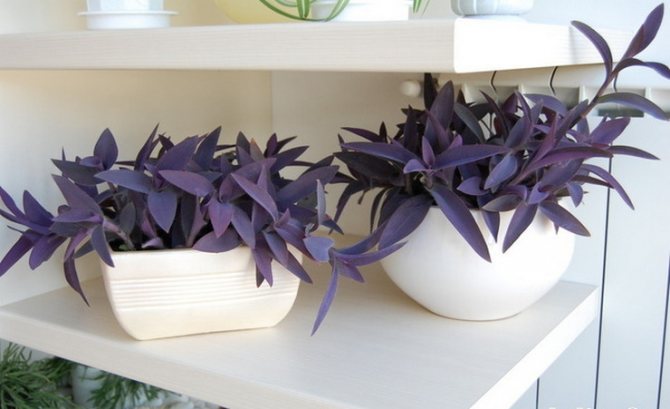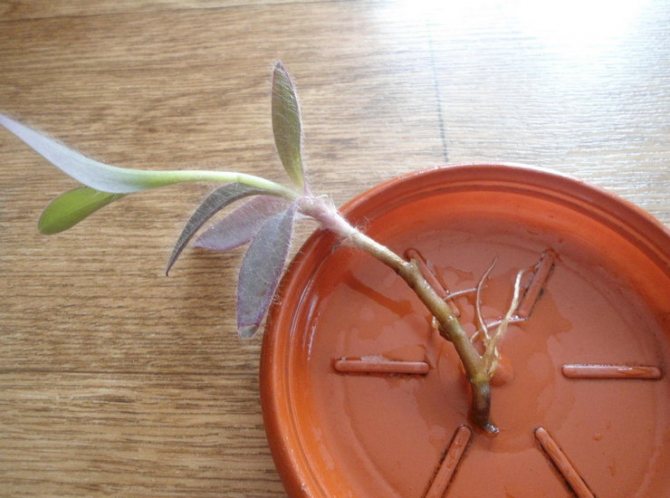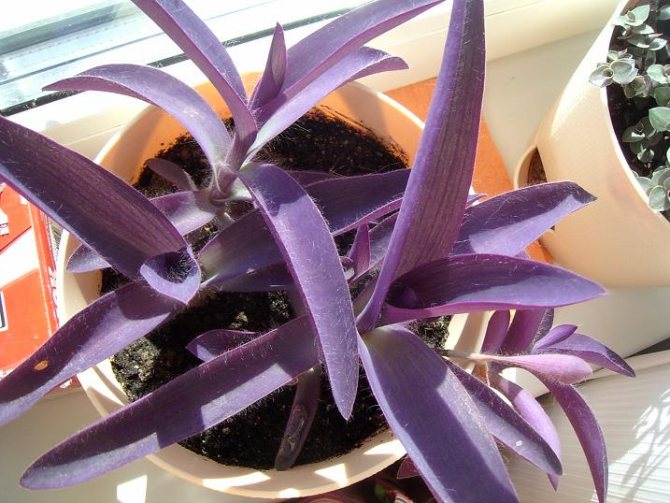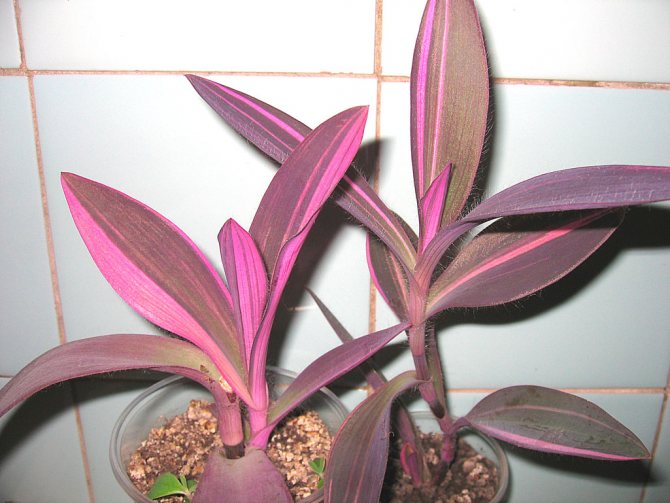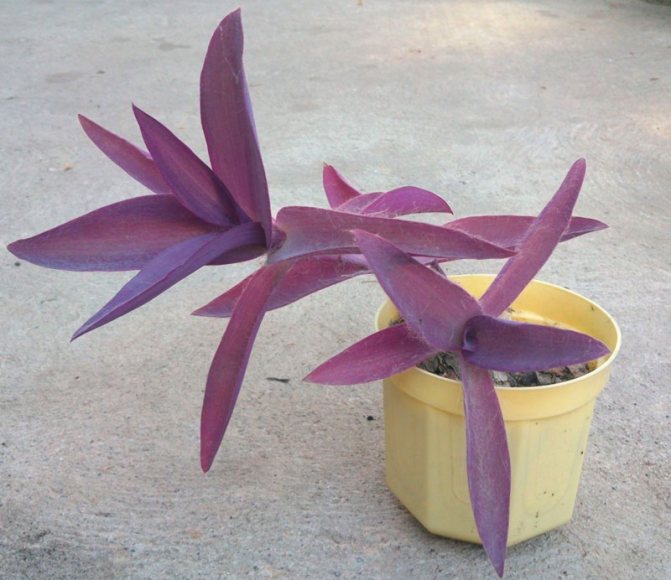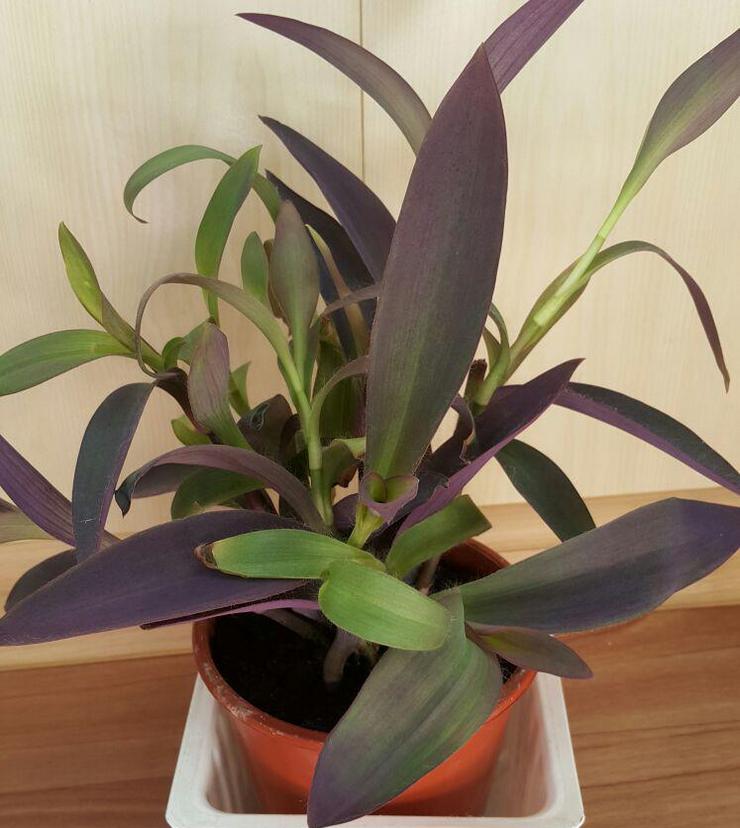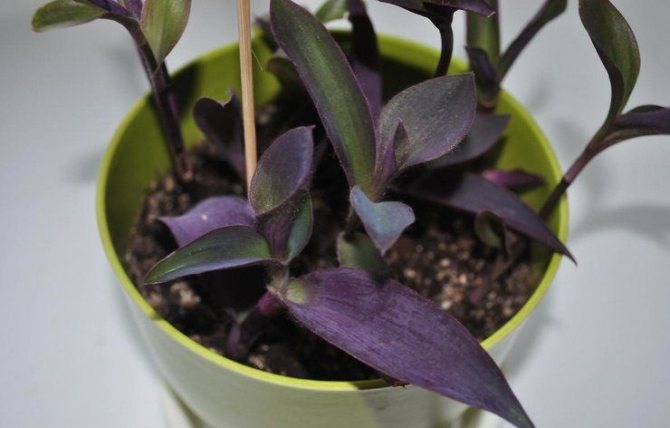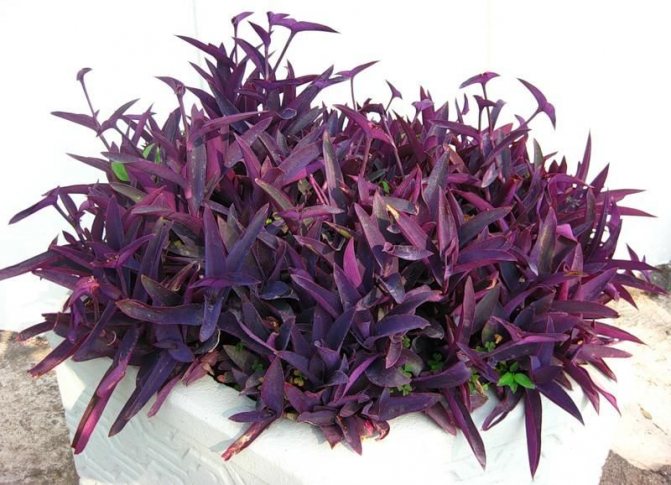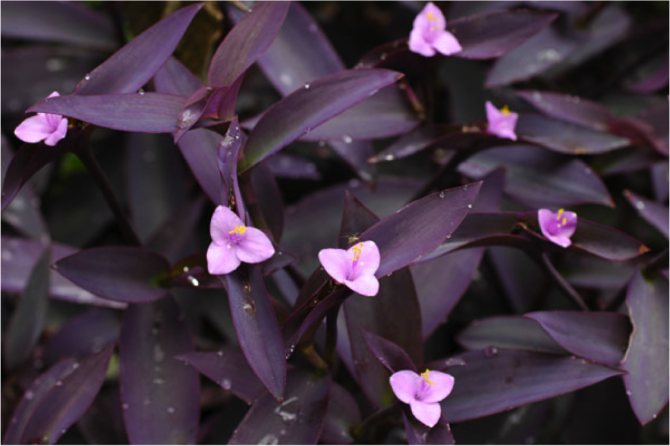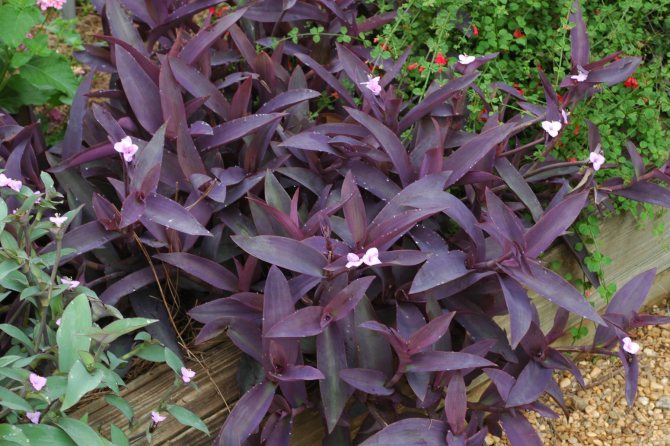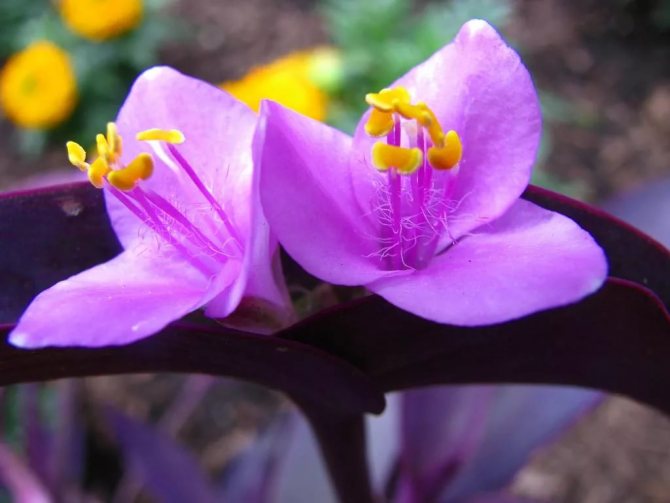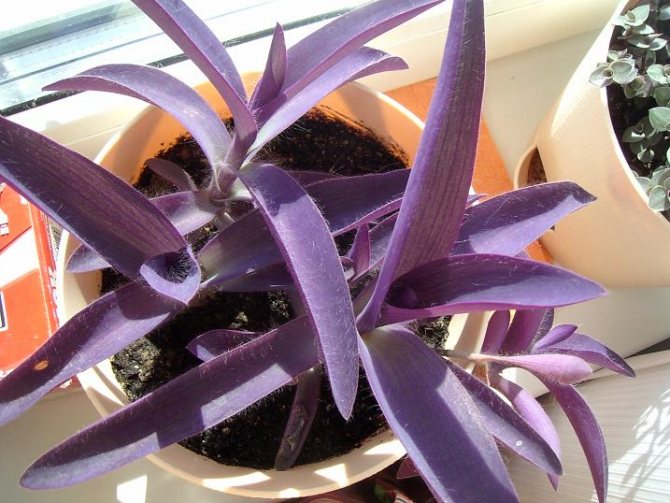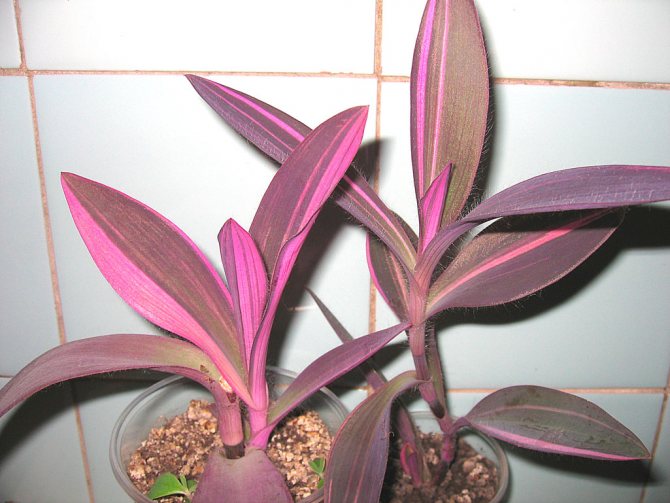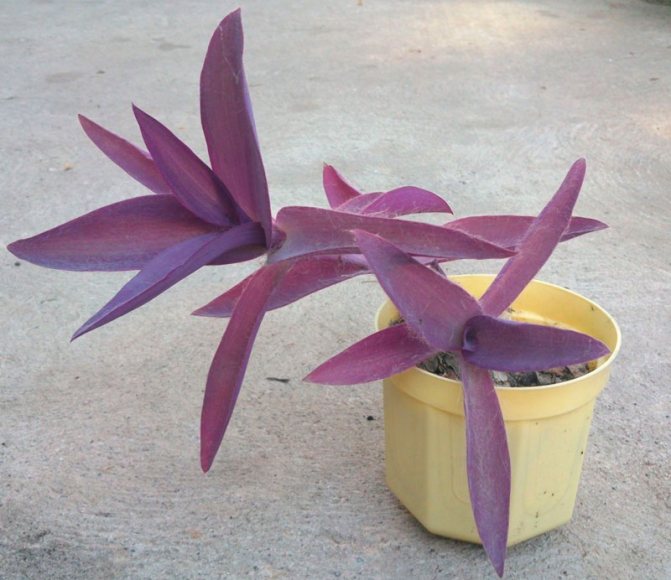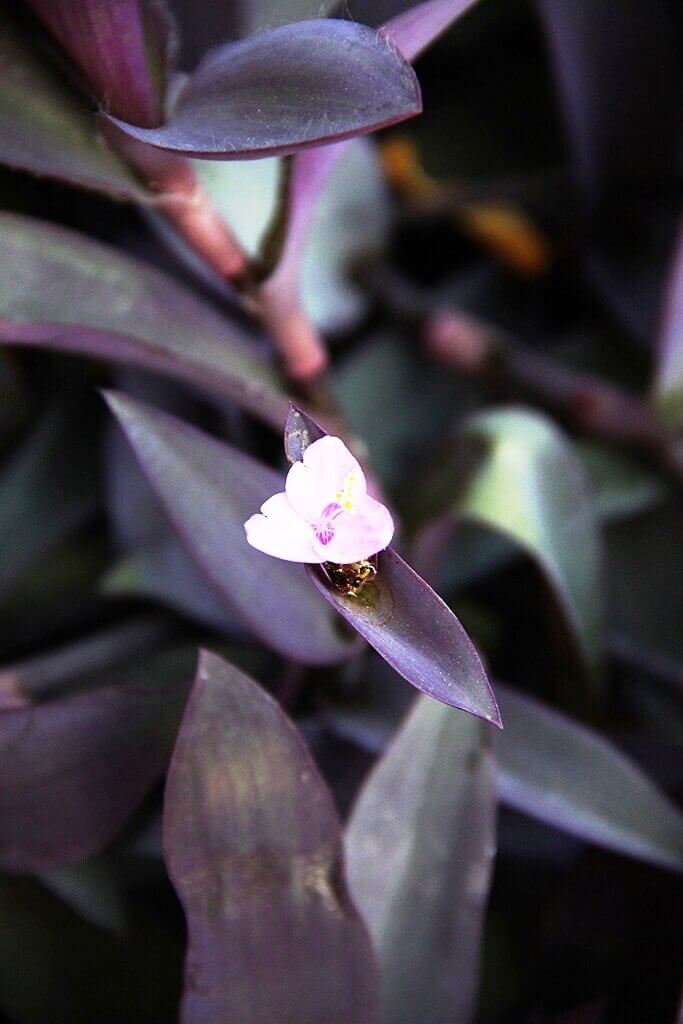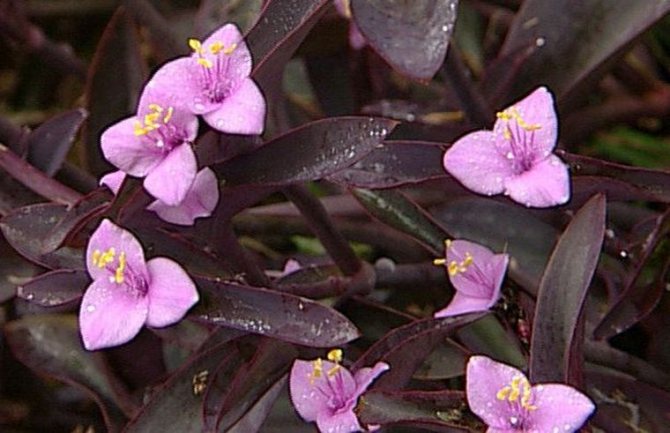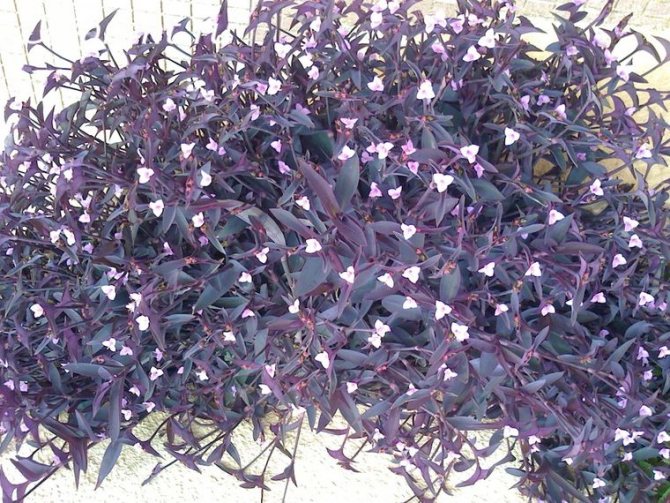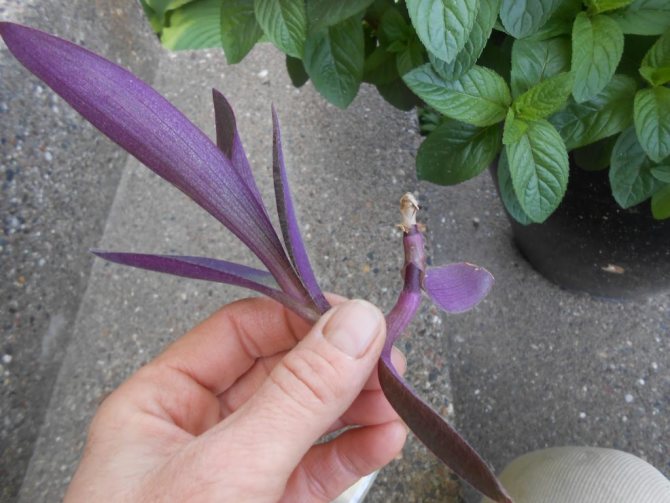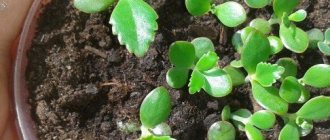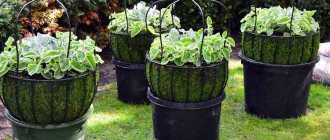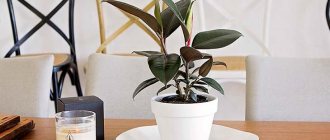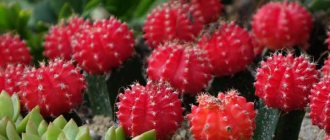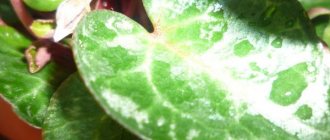Setcreasia purpurea (Setcreasea purpurea), which is also called Tradescantia pallida, is directly related to the genus Setcreasia, as well as to the Commelinaceae family. It occurs naturally on the Gulf Coast of Eastern Mexico.
This evergreen perennial has succulent creeping shoots that can reach 1 meter in length. Vaginal leaves, alternately located. Simple broadly lanceolate leaves reach about 10 centimeters in length. The front side of the foliage is green-purple and smooth, and the back side is purple in color and has a slight pubescence.
It blooms for a very long time from mid-spring to late summer. Small pink-purple flowers have 3 wide petals, which are collected in not very large inflorescences at the ends of the stems.
Description of purpurea mesh
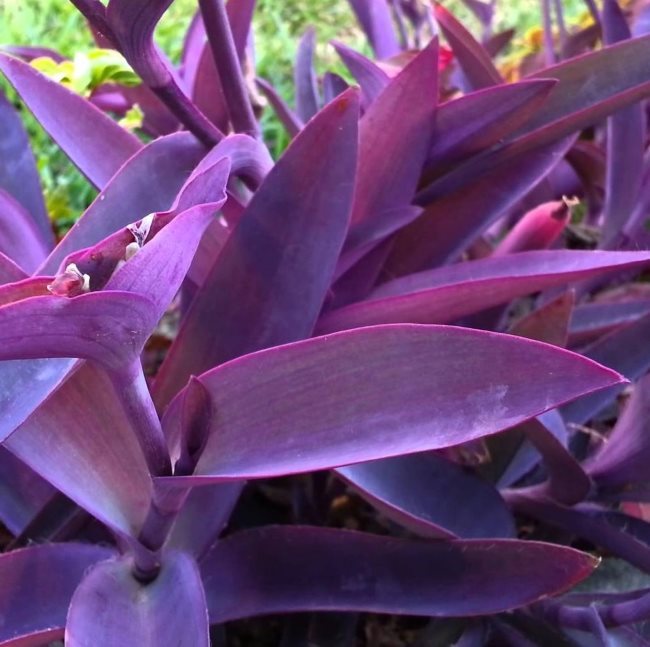
Beautiful purple leaves.
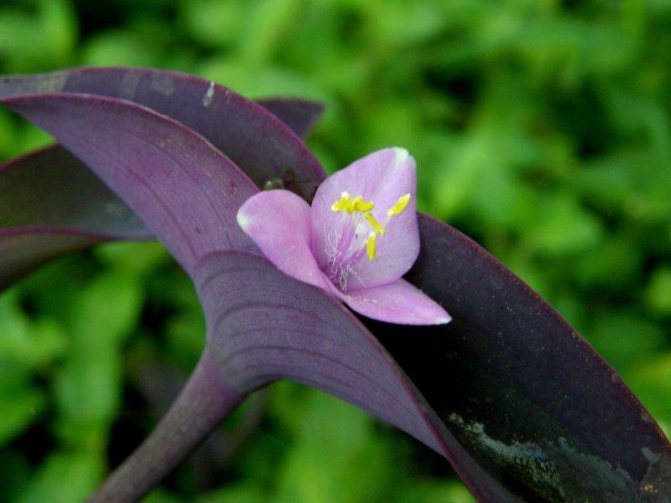

Delicate flower.
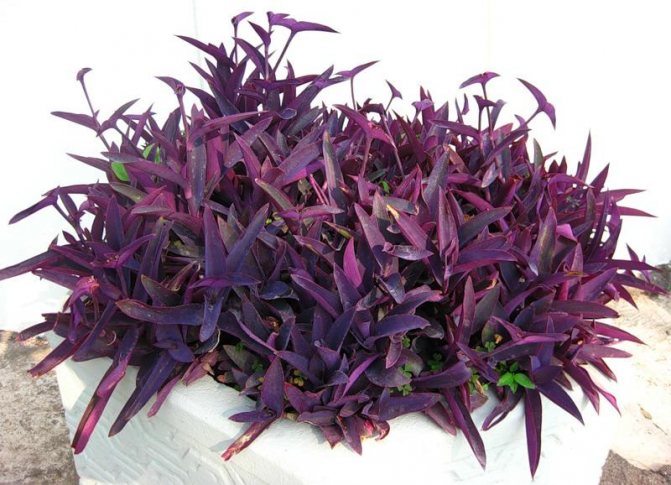

An adult bush.
Setcreasia from the deciduous vine family looks very beautiful due to its amazing leaves.
The leaves become a beautiful purple color only if there is sufficient light.
- The plant grows quickly, up to about 30 cm per year... This is necessary so that the flower is formed correctly and does not break under its own weight.
- Setcreasia blooms in summer and spring.
- Small flowers, pale pink and they consist of three small petals.
- For normal flowering, the plant needs to be fertilized. In addition, good lighting is required.
Choice when buying
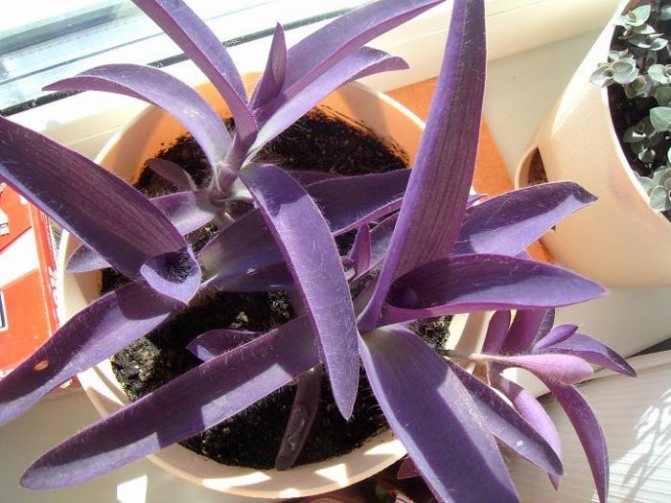

Netcreasia does not require special conditions for cultivation; it is quite satisfied with a well-ventilated residential or office space.
When buying a flower, you need to inspect it.
The plant should be resilient and there should be no signs of wilting or pests. If the leaves have scuffs or stains, then you should not buy a flower.
Important! At home, do not immediately put netcreasia together with other flowers. The plant will need adaptation.
Alternative view
Lovers of home flowers like to claim that their pets are able to control the energy in the house. For this reason, some plants are trying to quickly get it, and from some, on the contrary, they are trying to get rid of.
Tradescantia is a decorative plant that is easy to care for. Many are comfortable next to him, but some still argue that such loaches should in no case be kept in an apartment. Whom to believe?
Can Tradescantia be kept in the house?
Even if we do not consider different opinions about the ability of a flower to influence the life and activity of a person energetically, then the fact of its real chemical functions is difficult to deny:
1. Like any green plant, Tradescantia can improve mood and relieve stress (especially eye strain) by its appearance.
2. It is an excellent absorbent, absorbing harmful impurities from the air, purifying and moisturizing it.
3. This flower literally absorbs electromagnetic radiation, which is important for residents of modern apartments, where household electrical appliances are abundant.
Promotional video:
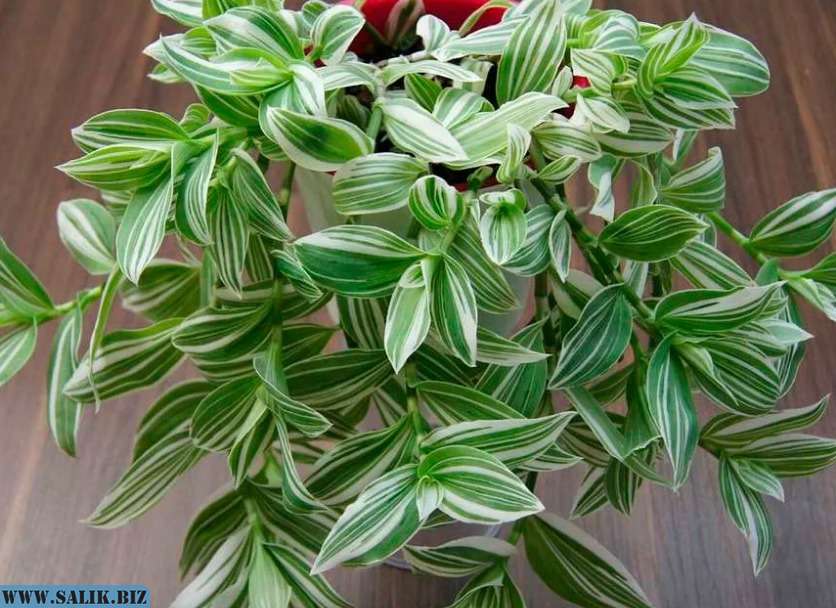

Tradescantia Albiflora.
Important! Recent studies have shown that Tradescantia stems contain many vitamins. Therefore, old shoots are even advised to cut, chop and add to food.
—
Given so many unique factors, questions about the possibility of keeping such a plant in the house should not even arise. It is not only possible, but also necessary!
The opinion of astrologers and the teachings of feng shui
According to feng shui, tradescantia is a real energy indicator. By the state of the flower, you can determine how a certain place will affect a person.
Advice! During a move or renovation, it is recommended from time to time to transfer the flower pot to different rooms, while in each you need to try to put it in a different way.
So, if you notice that somewhere the plant began to look bad, the leaves have dropped, then you cannot place a bed or a desk there. Most likely, this is evidence of the presence of an energy rift, which Tradescantia feels very subtly.
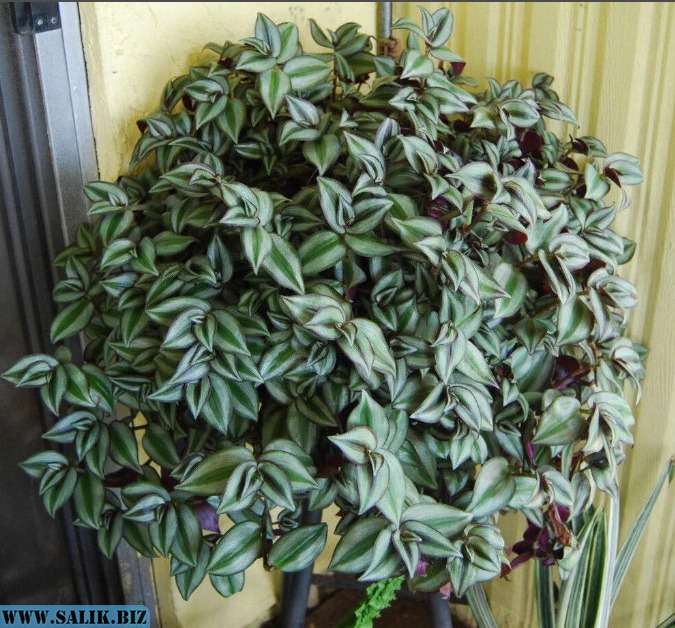

Regarding the care of the flower itself, esotericists argue that it is necessary not only to regularly refresh the leaves from the sprayer, but also to gently shake off the dust from them with your hands. Doing so will help him release negative energy and promote his attachment to you.
You should not leave the pot for a long time in resting places. It is better to make it a familiar habitat for a kitchen, a veranda or even a balcony. The latter option is not at all scary, because a temperature of about 15 ° C is convenient for tradescantia. Planting a flower in a tub of calm shades is perfect: white, green, blue is perfect.
Signs about tradescantia
There are many popular beliefs associated with the cultivation of this plant. Its ability to cleanse a room is associated not only with harmful impurities in the air, but also with the manifestation of negative clots of energy or negative entities. They say that for the greatest effect, you need to regularly take good care of the flower, show sincere love and admiration for it, and talk.
Only if these conditions are met, Tradescantia will repay you with its own support and help.
Advice! If you suddenly notice that the plant has withered or dried out even despite proper care of it, then it must be pulled out and buried in the ground away from home. In such situations, they believe that it was able to protect you from severe damage, the evil eye, or simply absorbed too much negativity.
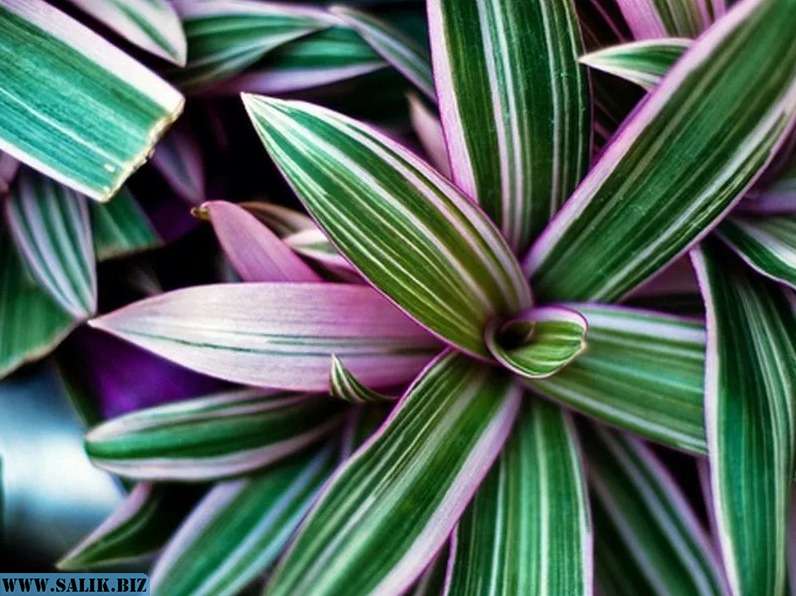

But at the same time, there is also the possibility of bad consequences. Since this representative of the flora belongs to the loaches, it tends to create some disorder in the room, and cause a feeling of anxiety in those present.
After purchasing, observe your condition and the atmosphere in the family. If you notice that you have become more absent-minded or cannot concentrate on something, and quarrels and misunderstandings have begun between relatives, then you still have to get rid of the green friend. In this case, it is recommended with good intentions to give it to a friend, while taking a token coin as payment.
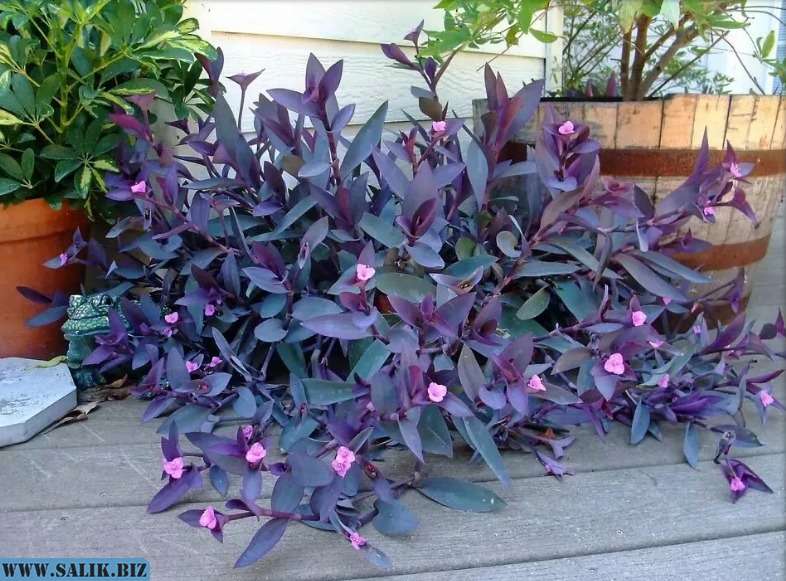

Each species has its own signs
Currently, there are more than 100 different types of tradescantia. Researchers distinguish them according to the size and shape of the leaves, color and, of course, ability. The most popular among amateurs are:
Virginia
It usually reaches a height of 55 cm. Around the middle of summer, it begins to actively bloom with bright pink and purple buds. It is famous for its ability to calm and charge a good mood.
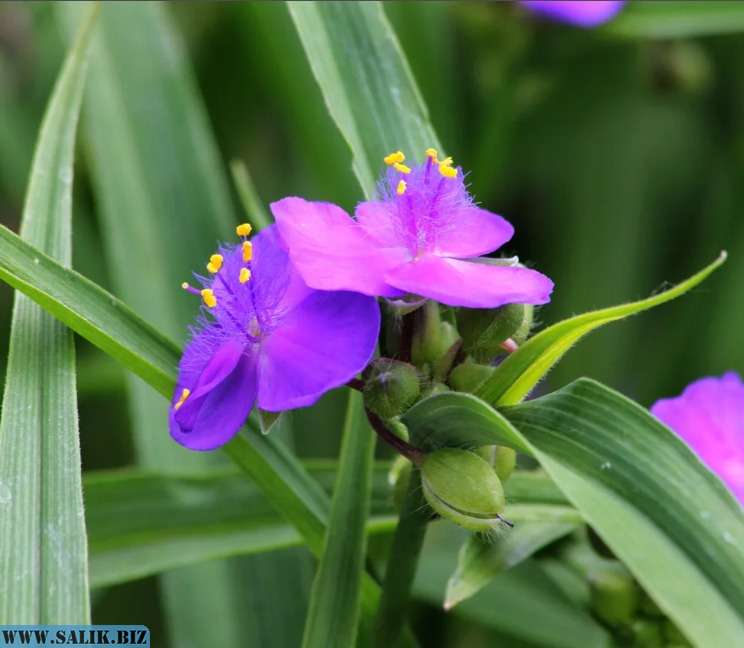

Blossfeld
A lush plant with purple stems and medium-sized leaves. His energy is aimed at the career growth of the owner, well-being and accompanying good luck everywhere. It is recommended to acquire such a companion in case of loss of self-confidence and low self-esteem.
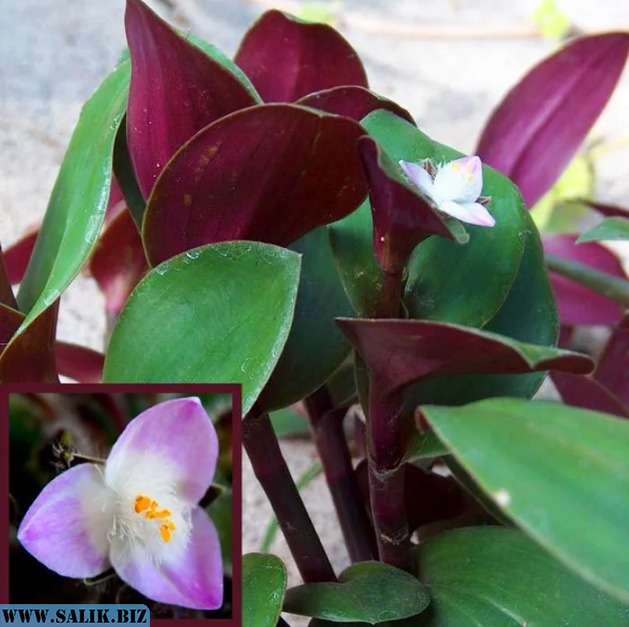

Zebrina
Ampel flower with oblong green leaves, in the middle of which there are silvery stripes. This species serves as one of the main defenders against rumors and evil eyes, protects from bad events and the appearance of ill-wishers for each family member.
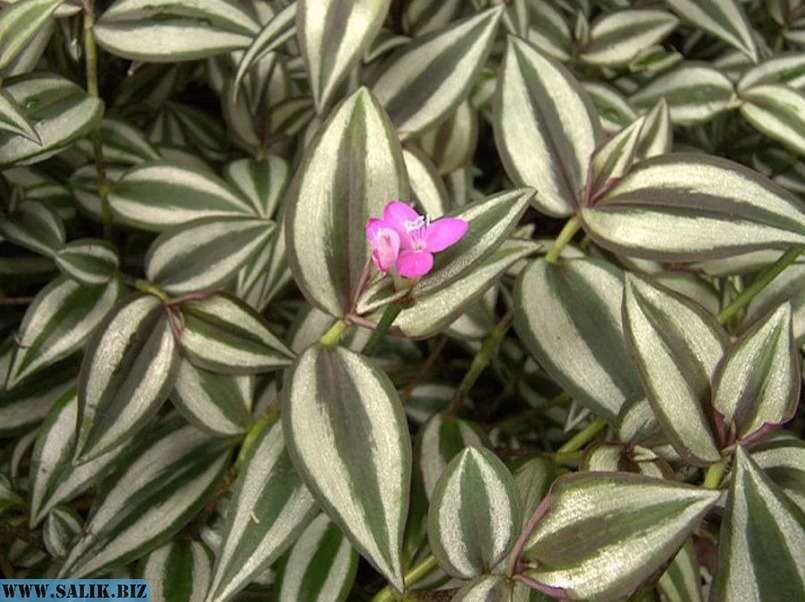

Anderson
Outwardly, it is very similar to Virginia Tradescantia. However, in this case, the height of the stems reaches 85 cm, and often this variety can even be found as a garden dweller. In the house where Anderson appears, relations between its inhabitants quickly begin to improve, all conflicts disappear, and everyone's mood rises.
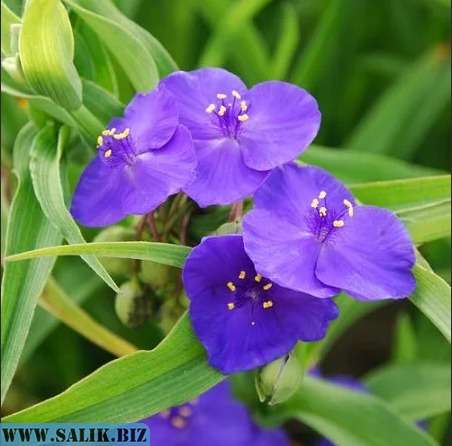

By the way, this plant also knows how to attract good friends and loyal comrades.
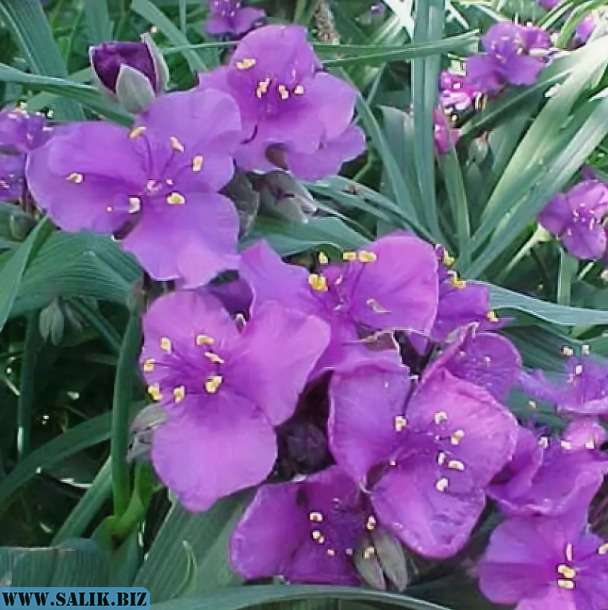

Anderson's Tradescantia Condre Grape.
Setcreasia purpurea
It can be presented in several forms: erect, creeping and branched. And in each such form, a lilac tint of the entire aerial part will be observed. Despite all the external beauty, such specimens must be treated extremely carefully, and for its habitat it is better to choose non-residential premises.
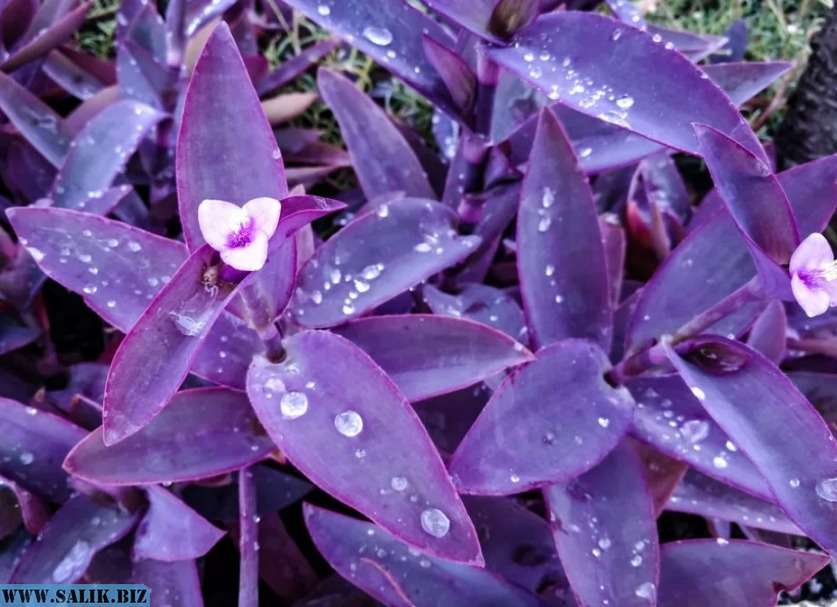

Purple Tradescantia very quickly absorbs all the surrounding negativity, and then, from an overabundance, begins to reflect it. For this reason, troubles and omissions can begin in the house.
As you already understood, each species has its own qualities and history. Will any of them become your helper and friend?
Plant properties
In some cases, the flower can be the cause of great joy.
Important! With proper care, care and love, he is able to help a single person find their soul mate in a very quick time. Also, the gratitude of the plant can manifest itself in improving the financial condition and quality of life, it will begin to seem to you that a cornucopia has been turned over on you.
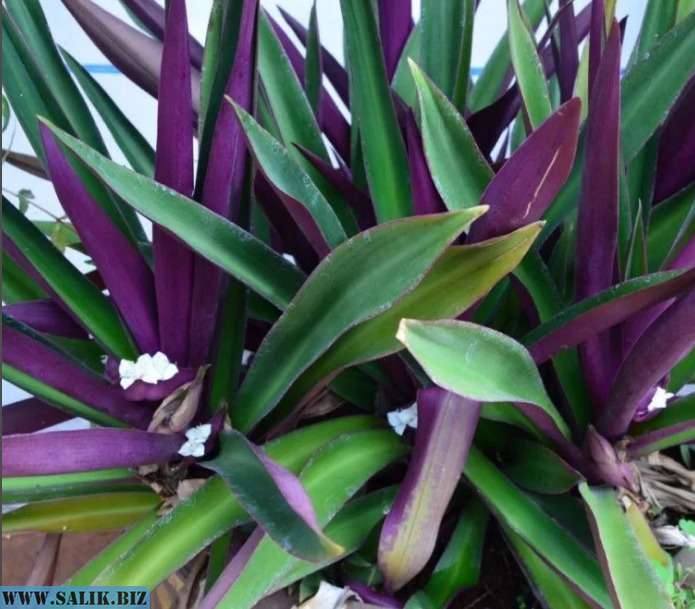

Another super property is the desire for justice, under the influence of tradescantia, all ill-wishers and liars will leave your life.
It can be hard to believe that a small houseplant can bring so many positive aspects to life. But until you try it yourself, you won't be able to find out. Good luck!
Zhanna Lyubarskaya
Soil mixture
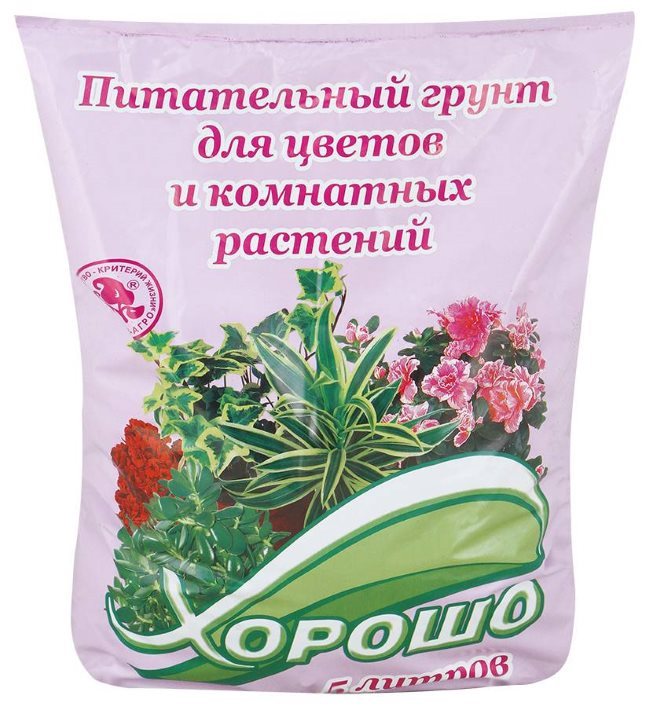

A suitable soil mixture can be purchased at any garden store - it should be a universal soil for indoor plants, to which you need to add baking powder.
There are no soil requirements, the main thingso that it contains components useful for a flower.
- Before planting the flower, you will need to make a good drainage layer in the pot, which will help prevent over-wetting the soil.
- Then add a layer of soil and plant the plant.
The pot should be the same width and height.
Magical properties
The people have numerous signs associated with indoor plants. Meshcreasia is an indicator flower.
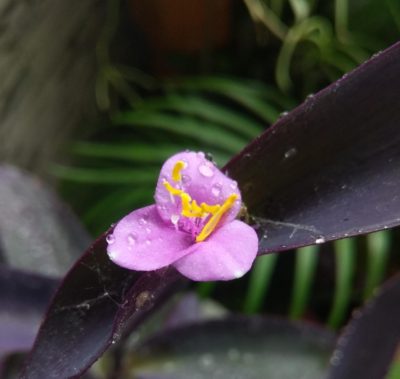

If you put it at home, then the electricity present in the room is instantly determined by the plant.
If a negative situation reigns in the house and a person lives - an energy vampire, the leaves will begin to rapidly turn yellow and crumble.
As for envious people, by giving them this kind of flower, it is possible to note in the near future that envy leaves them.
Using a flower for magical purposes, it is possible to protect oneself from unkind people, since the evil eye loses its own power where this plant resides.
Setcreasia purpurea has certain magical properties that are ready to assist its owner. The flower protects against a love spell, will be able to drive away negative emotions and release from stressful situations.
Illumination
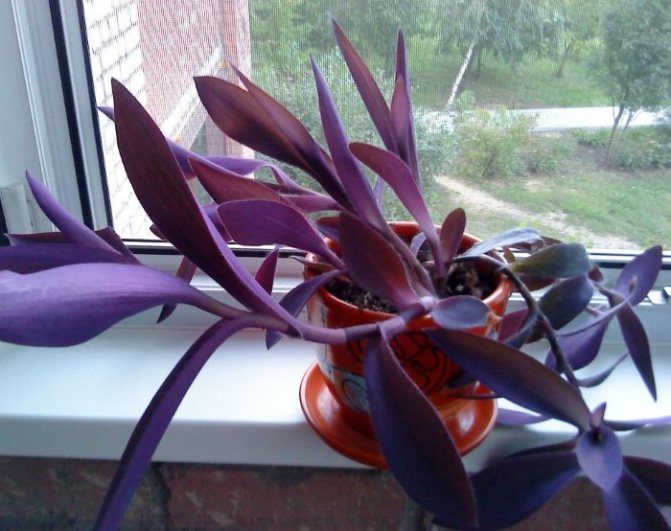

The color of netcreasia leaves depends on the correct lighting.
This plant prefers good lighting.
The flower should be in direct sunlight for about 2-3 hours per day.The rest of the time, you need to place it on a well-lit windowsill.
In cloudy weather, it is recommended to keep it under phytolamps.
If there is not enough light, the leaves will lose their attractive bright color and turn green, and the stems will quickly elongate. In addition, when there is a lack of lighting bloom won't come.
Main types
There are many types of plants, among which the most common are:
- 1 Striped. A distinctive feature of plants is the presence of oblong light stripes located along the entire leaf from the front side. Narrow stripes are very sparse, and are located closer to the edge of the leaves, to the central part of them, the lines increase significantly.
- 2Pink. The stripes are pink in color, they look very unusual. The reverse side of the leaves no longer has such a rich purple color.
- 3Multi-colored. It is characterized by a multi-colored color - from light to dark shades. Such changes occur on the face of the sheet.
Regardless of the species, plant care will be almost the same.
Air humidity and watering
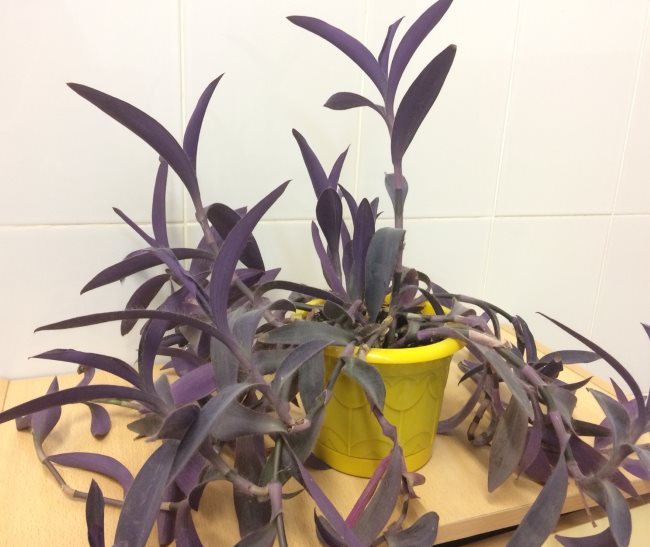

When watering the netcreasia, it is impossible to completely dry out the earthen coma and the bay.
Since the flower loves high humidity, you need to maintain it within 70–75%... This requires spray the space around the flower, but so that water does not fall on the leaves, as this can provoke the formation of white spot.
You need to water the plant all year round, even during the dormant period. Watering frequency depends a lot on the season.... In spring and summer, daily watering is required, and in winter only when the soil dries up to 3-4 cm.
Watering is needed plentiful, but it must be borne in mind that the soil should always remain moist enough, but not wet... If there is a lot of moisture, then the roots begin to rot and this will ultimately lead to the death of the flower. But you should not allow the soil to dry out either, since the leaves and shoots will lose their elasticity and dry out quickly.
For watering it is recommended to use only warm settled water... To increase the humidity, flower growers recommend pouring pebbles or expanded clay into a tray with a flower and pouring water, and then put a pot with a plant on top of the prepared layer.
Home use
Tradescantia is used for garden decoration, premises. It is also used to create flower arrangements. Due to its low allergenicity, even allergy sufferers can enjoy the beauty of this plant and the delights of floriculture. In addition, this plant has a variety of medicinal properties.
Beneficial features
Homemade tradescantia was recognized by the Italian biologist D. Pirerro. He was able to scientifically prove that this plant has a long list of pharmacological properties. Pirerro found in its composition a substance similar to inulin, which can significantly reduce the sugar content in the blood. Due to this element, Tradescantia (more precisely, its juice) is currently used as a therapy for patients with diabetes mellitus.
In addition, Dr. Pirerro was able to isolate a group of phytoncides that have significant antimicrobial activity and which were able to successfully destroy not only microorganisms, but even viruses. It turned out that these phytoncides are especially active in the treatment of a wide group of various infectious diseases of the gastrointestinal tract. In addition, the phytoncides obtained from Tradescantia fought amazingly against Koch's bacillus, which triggers tuberculosis. In our time, this study did not pass by European doctors, and now in South America, Tradescantia is successfully curing tuberculosis at various stages of the development of the disease.
Folk recipes
Traditional medicine presents many ways of using Tradescantia for medicinal purposes. These include:
- the juice;
- decoctions;
- balms;
- gruel;
- infusions (leaves are used);
- ointments;
- alcohol tinctures;
- powders.
If you need to get juice from a plant, then you need to remember that the medicinal properties of the juice last no more than 2 hours. If an infusion is prepared from the leaves of this medicinal plant, then only purified drinking water must be used. In no case should you take it from the tap, because the chlorine contained in it will destroy the phytoncides of sectreasia.
Traditional way of treating angina... A decoction is prepared from the leaves of the plant. If there are few leaves, you can add some stems.
- 50 g you need to pour 1.5 liters of boiling water.
- Then you should boil over low heat for 2-3 minutes.
- Let it brew for 2 hours and drain.
With such a decoction, it is necessary to rinse the throat, rinse the nose.
With a runny nose, after freeing the nasal passages, cotton swabs soaked in such an infusion are introduced into the sinuses. It is allowed to use juice instead. According to traditional medicine, the use of juice will be more effective in treating the common cold.
Diabetes mellitus treatment... Of course, Tradescantia will not completely save you from illness. But it is quite capable of significantly improving the patient's quality of life. For the treatment of this serious disease, a decoction of reticulum is used. To obtain it, do the following:
- Pour 100-150 grams of leaves and stems with a liter of cool drinking water;
- put on a quiet fire;
- waiting for a boil;
- hold for 2 minutes;
- the resulting broth is insisted for 2-3 hours;
- give the patient ½ glass three times a day before meals.
At the same time, it is required to drink alcohol or vodka tincture from this plant in the same way three times a day, but after a meal. Thus, it is necessary to be treated for 1 month, after which it is imperative to pause for 1 month and again repeat the course of treatment. Alternate medication for 6 months. During the course of treatment with netcreasia drugs, sugar levels should be monitored regularly.
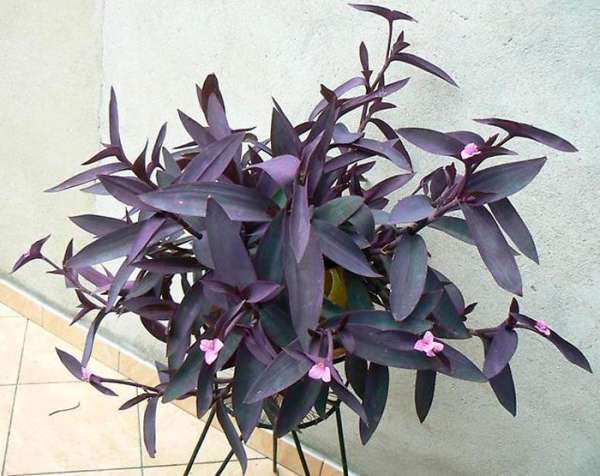

Setcreasia purpurea (Setcreasea purpurea), which is also called Tradescantia pallida, is directly related to the genus Setcreasia, as well as to the Commelinaceae family. It occurs naturally on the Gulf Coast of Eastern Mexico.
This evergreen perennial has succulent creeping shoots that can reach 1 meter in length. Vaginal leaves, alternately located. Simple broadly lanceolate leaves reach about 10 centimeters in length. The front side of the foliage is green-purple and smooth, and the back side is purple in color and has a slight pubescence.
It blooms for a very long time from mid-spring to late summer. Small pink-purple flowers have 3 wide petals, which are collected in not very large inflorescences at the ends of the stems.
Pruning
It is recommended to prune systematically.
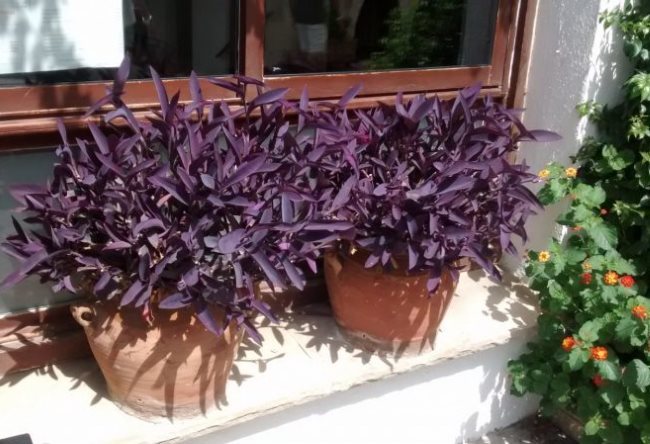

Pruning helps keep the bush tight and compact.
- It is advisable to do this before the active growth of the plant begins.
- It should be strong enough, since after pruning, only 2-3 cm.
In addition, you need to periodically pinch young shoots to form a beautiful and lush bush.
Tradescantia
Cordilina flower home care
For many plants, the main decorative component is not the flowers or the shape of the leaves, but the unusual color of the main vegetative part. So netcreasia is famous for its bright purple leaves and purple-brown stems.
The second name of the plant is Tradescantia, and perhaps it is under this synonym that we are more familiar with it. However, among all the known variety of Tradescantia, individual species can be distinguished, which differ in their decorative properties.
Setcreasia (Tradescantia) purple is famous, as already mentioned, for its color.Creeping and hanging shoots bear sessile elongated leaves with a slight purple-purple pubescence. At the ends of the shoots in good lighting, small, again purple, branches are formed, which do not differ in any significant decorative qualities, but completely complement the general purple-purple appearance of the entire plant.
Tradescantia is a widespread plant among modern novice growers, so it is not difficult to find and root a stalk of this plant. However, for those who wish to get acquainted with the whole variety of existing species and varieties, acquaintances alone may not be enough. The whole range of tradescantia can be found only in a large houseplant store and placed as a remote order - flowers delivery to Balashikha can be carried out quite quickly and with the preservation of all available material.
Setcreasia is unpretentious and does not require any special treatment.
Fertilization
In order for the netcreasia to be lush and pleasing with its flowering, it is important to periodically apply top dressing.
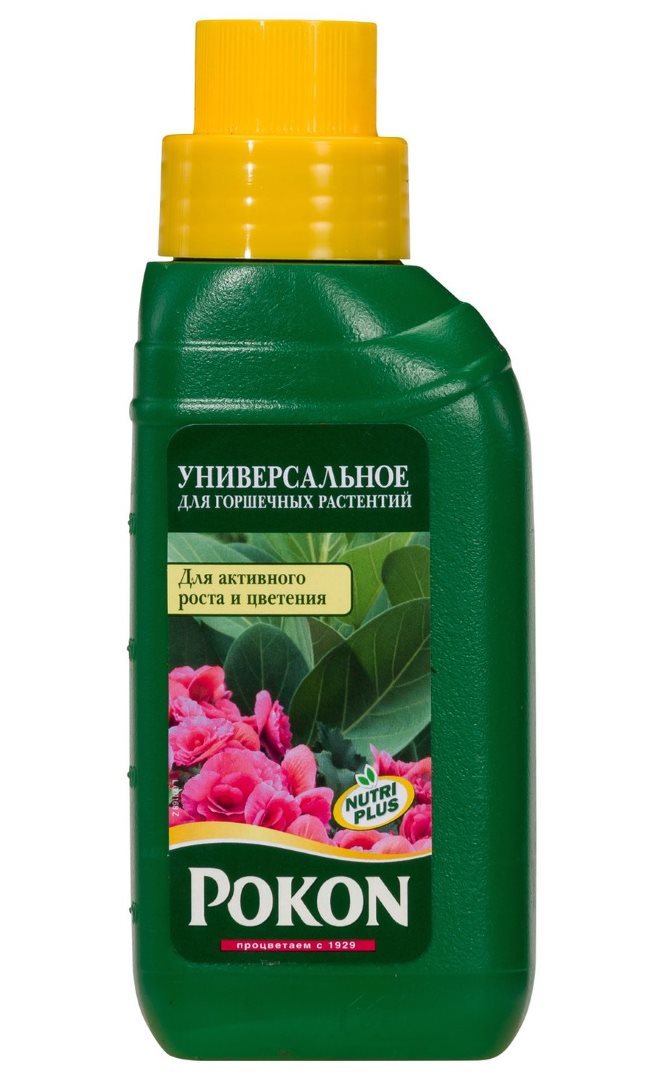

Any universal fertilizer is suitable for feeding.
For this, it is worth using universal fertilizers and special liquid fertilizing.
Fertilizer must be applied every 20-30 days... If the flower is at rest, no feeding is required.
Temperature
The favorable temperature for full-fledged growth and development of serissa differs in different seasons. For example, from spring to late summer, the thermometer should be in the range of 20-25 degrees and it is good if the plant during this period will be kept in the garden or on the balcony. Small changes in temperature are not dangerous, the main thing is that it does not get colder to 10 degrees Celsius or less.
In the colder months, the plant needs a cooler room to thrive.
Transplantation
The transplant should be carried out as needed.
Basically, the plant is transplanted in early spring, when the root system becomes cramped in the pot.
It must be remembered that the flower grows rather quickly and after a few years it is recommended to replace the netcreasia with a young plant.
Reproduction
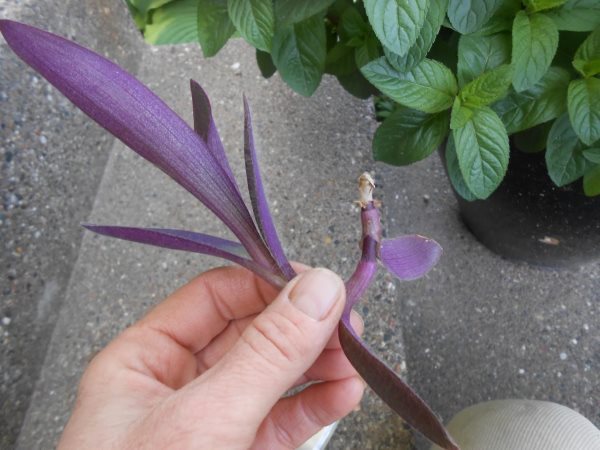

A stalk of purpurea netcreasia.
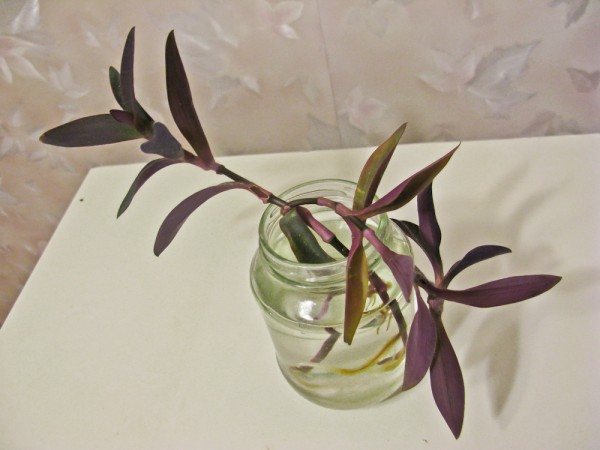

Rooting cuttings entering.
Reproduction can be carried out by seeds and cuttings. The first method is considered insufficiently effective and is used very rarely. Reproduction by cuttings is more common.
- To do this, place the cut cuttings in a container with water or plant them in a sand-peat mixture.
- When the cuttings take root, you need to transplant 3-4 pieces in a pot.
Video review
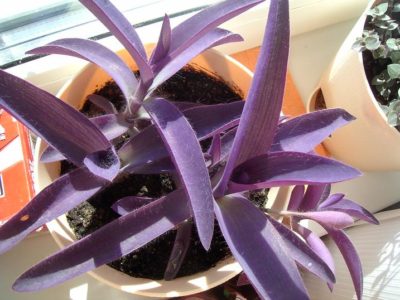

A plant called purpurea setcreasia, or otherwise called pale tradescania, belongs to the genus setcreasia, which belongs to the commeline family. In a wildly growing state, a similar culture can be found in its homeland on the shores of the Gulf of Mexico, which is located in the eastern part of Mexico.
A similar plant is a perennial, which is also evergreen. It has creeping shoots, the length of which in most cases reaches one meter. The leaves are simpler and their shape is broad-lanceolate. In length, such leaves can be about 10 cm.
On the front side, the leaf has a smooth base of green-purple color, while the back side contains the so-called pubescence.
The flowering period of such a culture begins in April and ends at the end of summer. The flowers are small in size and purple in color. One flower contains three petals, which are the same small inflorescences.
Photo
Pests
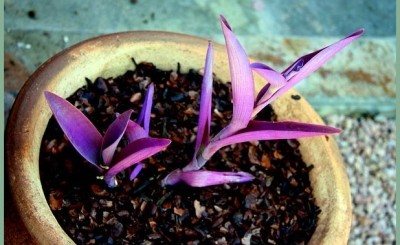

Netcreasia is not the most attractive flower for pests.
However, it can also be affected by such pests as scale insects and spider mites.
To prevent this from happening, it is necessary to inspect other plants weekly for the presence of pests, and at the slightest suspicion, quarantine the affected flower in a place remote from other plants.
If scale insects (they look like small shells) and spider mites have been found on the plant, it is necessary to start pest control immediately so as not to aggravate the situation.
Methods for dealing with the scabbard:
- Soap-alcohol solution, you will need 15 grams of soap, 10 ml of alcohol and a liter of water. All ingredients are mixed, and with the help of cotton wool, they are applied to the affected area, rinsed well.
- Solution can be used 10 g of soap and 20 g of machine oil, mix with water until lather and process the plant in the same way. After the procedure, the flower must be covered with a film and left for 6 hours.
- Another way is to grate garlic (about 4 cloves) mix with water, let it brew and spray the plant with this solution.
- With a strong defeat plants are treated with the drug acarin, or phytoverm.
Spider mite control methods:
- Wash with soapy water.
- Since it is not desirable to wet Setcreasia, "inhalation" of garlic is suitable for it. To do this, you need to chop the head of garlic, put it next to the diseased plant and cover with a transparent film.
- You can also spray the plant with infusion of garlic and rinse the affected areas.
To prevent the flowers from getting sick, you need to ventilate the room more often.
Recently, such ornamental plants as vines and ivy have become very popular. Read our materials on how to care for Tetrastigma Vuagnier, Helksina (soleirole), Dichorizandra, Indian Duchenea Tutti Frutti, Ruella, Tolmia, Cissus, Episia and Cyanotis.
The soil
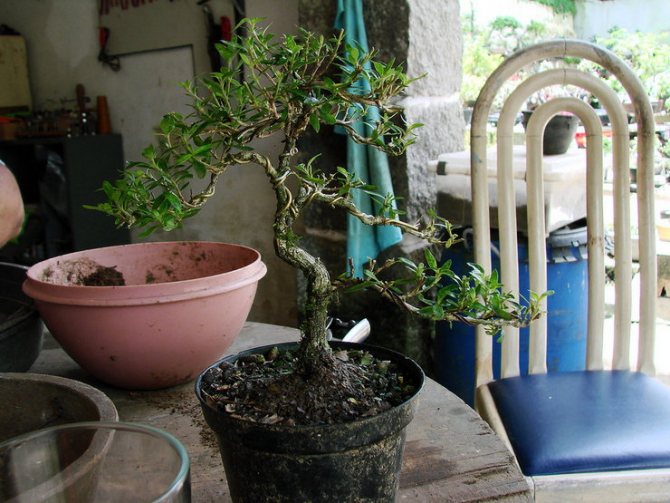

Experienced flower growers recommend choosing light, loose nutrient soils with a neutral pH level for growing serissa. The most suitable composition of the soil mixture: one part of peat and clay-sod land, two parts of coarse river sand. To protect the substrate from waterlogging and stagnant water, the bottom of the flower pot must be filled with expanded clay or other drainage material.
Propagation by cuttings


Cutting meshcreasia photo
Setcreasia reproduces very well with apical cuttings, which can be rooted in water or in a peat-sand mixture. To plant a plant, you need a small pot, it is better to place several cuttings there at once so that the bush is more lush.
How to plant meshcreasia with cuttings, the video will tell:
It can also take root by layering, propagate by seeds. But these methods are used very rarely.
I consider netcreasia non-toxic - only a small percentage of people can get irritation on the skin from contact with it.
If you need to be absent for a long time (on vacation, business trip), water the netcreasia well, but do not fill it. She will be able to withstand your absence for about a week and a half. If you will be away even longer, it is better to leave the plant on a pallet with damp moss or expanded clay.
Reproduction of serissa
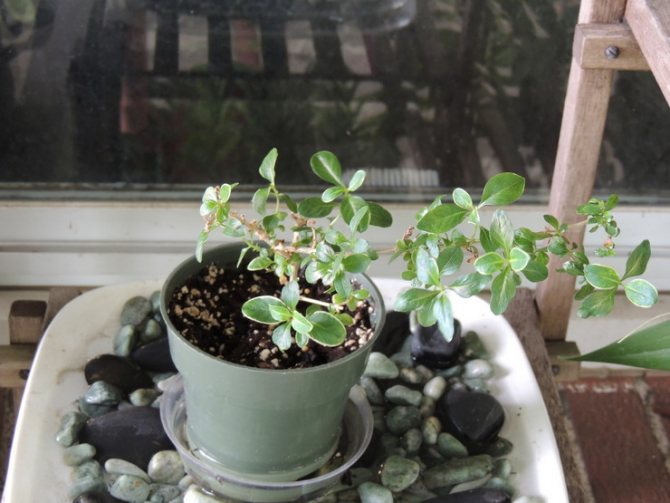

The simplest and most common way to propagate serissa is by cuttings. For rooting, it is recommended to take non-lignified cuttings. They are cut from the tops of the shoots so that there are at least three internodes on each cuttings. Rooting takes place in a special loose nutrient substrate in greenhouse conditions. You can build a mini-greenhouse with mandatory bottom heating, which will contribute to the rapid formation of the root system.
[collapse]
Growing problems
Growing problems with this flower are rare. Most of them are associated with violation of the rules of care:
- Spider mite. It is difficult to see it, but the problem can be identified by the fact that young leaves begin to wither and fall off, and if you look at them in front of the sun, you can see a thin web. Acaricides are used to get rid of.
- Whitefly.It is easily detected by insects with white wings that sit on the plant or fly next to the pot. To get rid of the whitefly, you need to carry out insecticide treatments.
- Shield. Looks like brown plaques on stems and leaves. The most effective way to deal with them is to mechanically pick them up by hand or wipe with alcohol after spraying with an insecticide.
- The ends of the sheets or shoots dry out. This pattern can be observed with dry air, hot air flows from heating radiators, or excessive growth of the root system with filling the entire pot.
- The withering away of old foliage. Sometimes observed from dry air, but for older plants indicates the need for formative pruning.
- Elongated shoots with small dull foliage. This picture indicates a lack of lighting, you need to place the pots closer to the window.
- White spots. Occur with sunburn. The damaged leaves are cut off.
- Wet brown spots. Appear with excessive watering. In this case, the flower must be transplanted into a new substrate, after checking and cutting off all rotten roots.
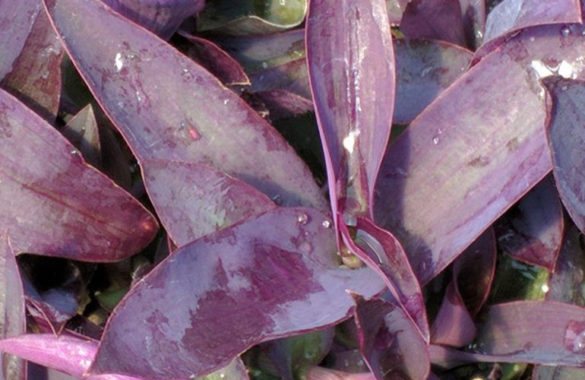

Success secrets
Serissa is a light-loving shrub, but an excess of direct sunlight leads to the formation of burns on ornamental leaves. Therefore, the plant is best placed on the west or east side of the room. On the northern windowsill, Serissa may not bloom due to poor lighting.
With the onset of spring, when the last frost is already behind, the shrub can be taken out into the fresh air. As a result, the process of formation of snow-white buds will not be delayed for a long time, and the flowering will be massive.
For the same purpose, the plant is provided with cool conditions in winter, when the air temperature is kept within + 13-18 ° С. Temperatures below + 10 ° С negatively affect the general condition of the plant. Serissa is also afraid of drafts, sudden temperature changes and does not tolerate being near central heating radiators.
During a period of active growth, normal room temperature is best suited for this tropical specimen.
Serissa is very sensitive to humidity in the room where it grows. Therefore, frequent spraying with warm, filtered water in summer and winter will bear fruit: the plant will grow well, develop, and bloom in a timely manner and profusely.
The bush is watered sparingly, as the topsoil dries out every five to six days. Stagnation of moisture in the pot is highly undesirable. In the autumn-winter period, the soil is very rarely moistened. The plant is quite sensitive to waterlogging and may start to rot.
Serissa is a somewhat capricious ornamental shrub, so some novice growers may face a number of problems in maintaining the spectacular Tree of a Thousand Stars. However, a positive result will make you forget all the difficulties of growing it.

